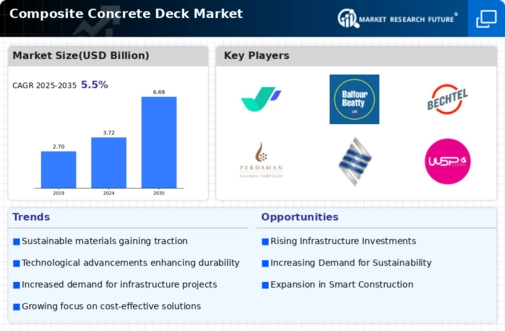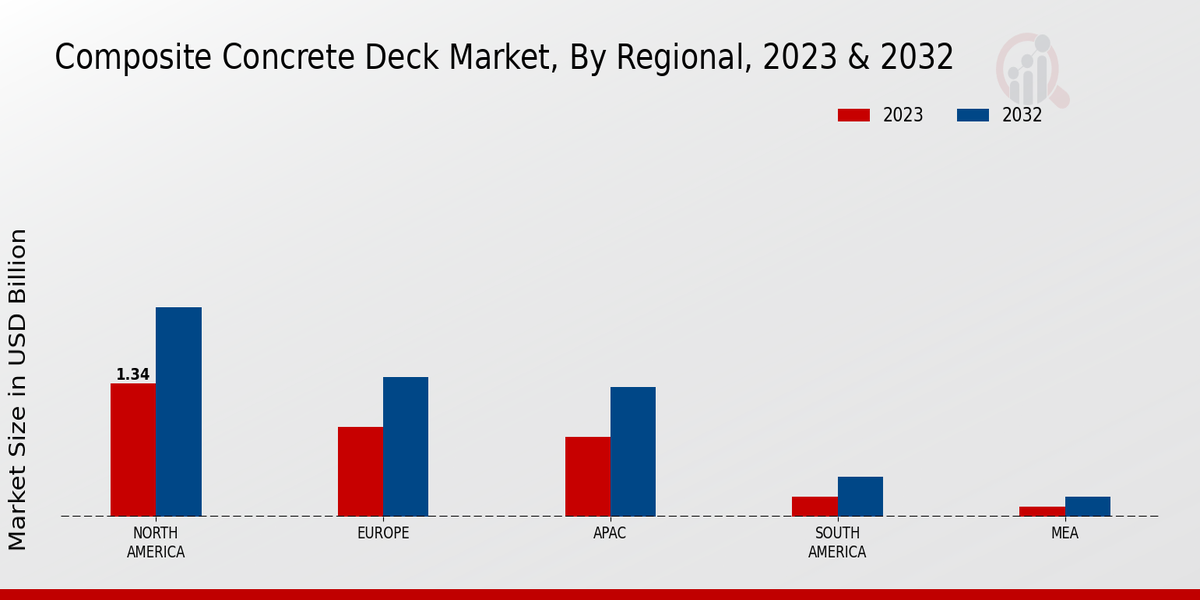Market Growth Projections
The Global Composite Concrete Deck Market Industry is poised for substantial growth, with projections indicating a market value of 3.72 USD Billion in 2024 and an anticipated increase to 6.69 USD Billion by 2035. This growth trajectory reflects a compound annual growth rate (CAGR) of 5.48% from 2025 to 2035. The increasing adoption of composite materials in construction, driven by their superior performance characteristics and sustainability benefits, suggests a robust future for the industry. As stakeholders recognize the advantages of composite concrete decks, the market is likely to expand, presenting opportunities for innovation and investment.
Growing Infrastructure Development
The Global Composite Concrete Deck Market Industry is experiencing a surge due to increasing infrastructure development across various regions. Governments are investing heavily in transportation networks, bridges, and commercial buildings, which require durable and efficient construction materials. For instance, the global market is projected to reach 3.72 USD Billion in 2024, driven by the need for sustainable and resilient infrastructure. This trend is particularly evident in developing nations, where urbanization is accelerating. The demand for composite concrete decks, known for their strength and longevity, aligns with these infrastructure goals, suggesting a robust growth trajectory for the industry.
Rising Demand for Sustainable Construction
Sustainability is becoming a pivotal factor in construction, influencing the Global Composite Concrete Deck Market Industry. As environmental concerns grow, builders are increasingly seeking materials that reduce carbon footprints and enhance energy efficiency. Composite concrete decks, which often incorporate recycled materials, are seen as a viable solution. The anticipated growth of the market to 6.69 USD Billion by 2035 underscores this shift towards eco-friendly construction practices. Additionally, regulatory frameworks promoting sustainable building practices further bolster the demand for composite solutions, indicating a long-term trend that could reshape the industry landscape.
Increased Urbanization and Population Growth
Urbanization and population growth are key drivers of the Global Composite Concrete Deck Market Industry. As more people migrate to urban areas, the demand for housing, transportation, and public infrastructure escalates. Composite concrete decks, with their ability to support heavy loads and resist wear, are increasingly utilized in urban construction projects. This trend is expected to contribute to a compound annual growth rate (CAGR) of 5.48% from 2025 to 2035. The need for efficient and durable construction solutions in rapidly growing cities positions composite concrete decks as a preferred choice among builders and developers.
Regulatory Support for Infrastructure Projects
Regulatory frameworks supporting infrastructure development play a crucial role in the Global Composite Concrete Deck Market Industry. Governments worldwide are implementing policies that facilitate the construction of critical infrastructure, including highways, bridges, and public facilities. These regulations often prioritize the use of advanced materials like composite concrete decks, which offer enhanced durability and performance. As a result, the market is poised for growth, with projections indicating a rise to 6.69 USD Billion by 2035. This regulatory environment not only encourages investment but also fosters innovation in construction practices, further solidifying the role of composite materials in modern infrastructure.
Technological Advancements in Material Science
Innovations in material science are significantly impacting the Global Composite Concrete Deck Market Industry. Advances in composite materials enhance the performance characteristics of concrete decks, making them lighter, stronger, and more resistant to environmental stressors. These technological improvements not only increase the lifespan of structures but also reduce maintenance costs. As the industry evolves, the integration of smart technologies into construction materials is likely to become more prevalent. This trend may attract new investments and drive market growth, as stakeholders seek to leverage cutting-edge solutions for enhanced structural integrity and efficiency.














